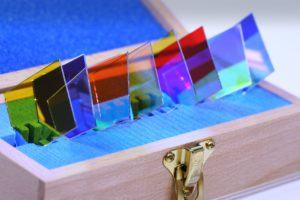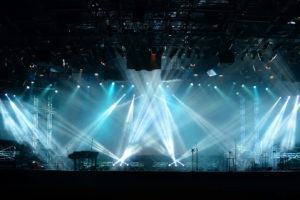How Dichroic Filters Enrich the Entertainment Lighting Experience
14th May 2019In any entertainment setting, lighting plays a crucial and very powerful role. It sets the scene; it helps to tell a story and it works to create a mood. Lighting should be considered just as important as music in all these roles. Take it away, and the experience for the audience would be bland and unengaging. In order to fulfil its responsibilities however, lighting used on stage and in television and film making needs to create a true to life, natural atmosphere.
If light appears unnatural, or it is not true to the scene it is responsible for setting or the mood it is supposed to be creating, then it is always going to be challenging to keep an audience captivated.
 In lighting systems, certain wavelengths will cause outgoing light to appear unnatural with colours seeming distorted or washed out. With these wavelengths removed however and the outgoing light corrected, a far more natural and intensely rich colour is produced. But how to correct the outgoing light and resolve the issue? This is where dichroic filters play a leading role.
In lighting systems, certain wavelengths will cause outgoing light to appear unnatural with colours seeming distorted or washed out. With these wavelengths removed however and the outgoing light corrected, a far more natural and intensely rich colour is produced. But how to correct the outgoing light and resolve the issue? This is where dichroic filters play a leading role.
Dichroic filters are accurate colour filters designed to efficiently transmit certain regions of the visible spectrum, whilst reflecting others. The filters are able to filter white light to produce light that is perceived to be colour rich.
How do dichroic filters work?
A type of interference filter, dichroic filters produce colours just as oil films do on water. In place of an oil film however are alternating layers of optical coatings bearing differing refractive indices. These coatings are applied to a borosilicate glass substrate. The interfaces that exist between the layers of the various indices lead to phased reflections which selectively reinforce particular light wavelengths, and interfere with others.
Longpass dichroic filters block a select band of shorter wavelengths, whereas shortpass filters block a select band of longer wavelengths. Bandpass filters transmit a variety of wavelength bands determined by two cutoff wavelengths. From near ultraviolet to near infrared, dichroic filters can be created at any particular wavelength.
Dichroic filters can be customised so that the frequency of the passband is as narrow or wide as required, which for entertainment lighting designers opens up realms of possibilities.
What are the benefits of dichroic filters in entertainment lighting systems?
 Because unwanted wavelengths are not absorbed but instead reflected, dichroic filters do not absorb any undesired energy during the operation, which means they do not become anywhere near as hot as standard filters. This makes them suitable for the highest powered lighting systems, including those used in film making. Dichroic filters will not deform, melt or degrade in performance except at several hundreds of degrees Celsius.
Because unwanted wavelengths are not absorbed but instead reflected, dichroic filters do not absorb any undesired energy during the operation, which means they do not become anywhere near as hot as standard filters. This makes them suitable for the highest powered lighting systems, including those used in film making. Dichroic filters will not deform, melt or degrade in performance except at several hundreds of degrees Celsius.
The light produced by dichroic filters is well saturated in colour, presenting exceptional purity and uniformity.
Dichroic filters offer a far more extended lifespan than traditional filters. Because the colour forms part of the layers, it will not bleach out over the filter’s lifetime. This is of particular importance for long-running theatrical shows where design integrity is essential.
How are dichroic filters used in entertainment lighting?
Dichroic filters have been used widely in entertainment lighting for around two decades. With stage and studio lighting systems now more powerful and therefore hotter than ever before, the polyester predecessor of the glass dichroic filter would never be able to survive such extremes.
 Dichroic filters act as colour correctors, adjusting the light spectrum to create the right spectral balance. For indoor applications, colour temperature blue (CTB) filters convert tungsten light to higher temperature daylight, whilst colour temperature orange (CTO) filters convert high temperature daylight to tungsten.
Dichroic filters act as colour correctors, adjusting the light spectrum to create the right spectral balance. For indoor applications, colour temperature blue (CTB) filters convert tungsten light to higher temperature daylight, whilst colour temperature orange (CTO) filters convert high temperature daylight to tungsten.
Dichroic filters are also used to create gobos in lighting products. Gobos are widely used in stage lighting to manipulate the shape of the light cast, for example producing patterns on stage sets such as a starry sky or a shadowy wood. The benefit of using dichroic filters as gobos is that they can include coloured areas. This is achieved by layering different coloured filters, or by varying the thickness of the coating on a single piece of glass. This makes it possible to actually transform a colour photograph or any artwork into a gobo.
Quality Assured Dichroic Filters from Knight Optical
 Knight Optical is a world-leading supplier of a vast range of optical components and has been a respected supplied of dichroic filters to the entertainment lighting industry for many years.
Knight Optical is a world-leading supplier of a vast range of optical components and has been a respected supplied of dichroic filters to the entertainment lighting industry for many years.
Whether stock size or wavelength, or custom created to your individual specification, your dichroic filters are guaranteed in accuracy to the highest degree thanks to our state-of-the-art metrology laboratory and quality testing procedures.
We regularly work closely with our customers to produce filters to suit innovative new lighting technologies and to withstand the demands of today’s intensely powerful equipment. If you would like to talk to us about your particular project, please get in touch with our multilingual technical sales team.